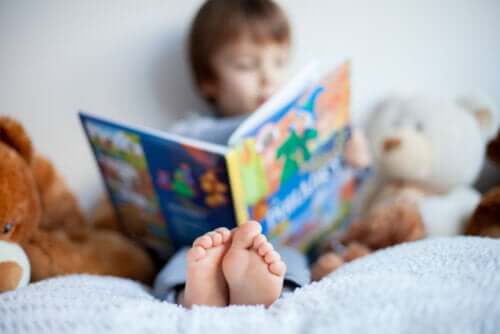Children's Books that Break Down Gender Stereotypes


Written and verified by the psychologist Ana Couñago
It’s important to educate boys and girls of the 21st century on equality. To do so, it’s important to break down gender stereotypes in any way possible. For example, through children’s literature.
Stories are a great educational resource when it comes to passing on certain social values. This is because, for children, the characters in these fictional stories are role models for them to follow and imitate.
What are gender stereotypes?
To understand and break down gender stereotypes, we must first understand the meaning of this concept. We can define gender stereotypes as a belief system shared by culture and society.
This belief system attributes certain roles and typical behaviors to women, and others to men. In other words, they define certain roles and behaviors as “feminine” and others as “masculine.”
Currently, we know that these preconceived ideas are simplistic and erroneous. Just the same, they continue to reproduce and pass down from one generation to the next through the socialization process. When little ones socialize, they take in these thoughts during their first years of life.

But, as gender stereotypes are constructed and learned, rather than innate, we can modify them through the education we give younger generations. We should prevent children from getting trapped by these stereotypes. Otherwise, they may assume certain character traits, emotions, physical characteristics, behaviors, interests, cognitive abilities, etc, simply because that’s what’s expected of their gender.
Children’s books that dismantle gender stereotypes
For years, classic children’s stories have perpetuated gender stereotypes, giving off completely sexist messages. Many of these stories portray men as brave, adventurous, and heroes. At the same time, they depict women as passive characters, waiting for some man to save them from an evil godmother or other sorts of danger.
Fortunately, in this day and age, there are many children’s stories that help children dismantle gender stereotypes. These stories help boys and girls grow up with gender equality. Below, we’ll recommend a few of our favorites:
Do Princesses Wear Mountain Boots? By Carmela LaVigna Coyle
This is the story of a very curious and energetic girl who isn’t sure if she’s an authentic princess. This doubt causes her to ask her mother a number of questions, and her mother responds in a very ingenious way. Do Princesses Wear Mountain Boots? encourages self-acceptance and self-confidence.

Candy Pink, by Adela Turin
The main character in this story is Margarita, an elephant that lives in a society in which males and females receive different upbringings. What’s more, Margarita is the only elephant in her group that doesn’t have pink skin which, at first, concerns her very much.
However, her parents stop making a big deal of this aspect. Finally, she feels free, which paves the way to equality for the rest of her mates.
Revolting Rhymes, by Roald Dahl
This book from one of our favorite authors includes a variety of classic children’s stories. But here, Snow White, Little Red Riding Hood, Goldilocks, take a new turn. Rather than tell the stories the way they’ve been told for generations, Roald Dahl reinvents them. This fantastic book sends much more modern and appropriate messages to today’s young readers.
It’s important to educate boys and girls of the 21st century on equality. To do so, it’s important to break down gender stereotypes in any way possible. For example, through children’s literature.
Stories are a great educational resource when it comes to passing on certain social values. This is because, for children, the characters in these fictional stories are role models for them to follow and imitate.
What are gender stereotypes?
To understand and break down gender stereotypes, we must first understand the meaning of this concept. We can define gender stereotypes as a belief system shared by culture and society.
This belief system attributes certain roles and typical behaviors to women, and others to men. In other words, they define certain roles and behaviors as “feminine” and others as “masculine.”
Currently, we know that these preconceived ideas are simplistic and erroneous. Just the same, they continue to reproduce and pass down from one generation to the next through the socialization process. When little ones socialize, they take in these thoughts during their first years of life.

But, as gender stereotypes are constructed and learned, rather than innate, we can modify them through the education we give younger generations. We should prevent children from getting trapped by these stereotypes. Otherwise, they may assume certain character traits, emotions, physical characteristics, behaviors, interests, cognitive abilities, etc, simply because that’s what’s expected of their gender.
Children’s books that dismantle gender stereotypes
For years, classic children’s stories have perpetuated gender stereotypes, giving off completely sexist messages. Many of these stories portray men as brave, adventurous, and heroes. At the same time, they depict women as passive characters, waiting for some man to save them from an evil godmother or other sorts of danger.
Fortunately, in this day and age, there are many children’s stories that help children dismantle gender stereotypes. These stories help boys and girls grow up with gender equality. Below, we’ll recommend a few of our favorites:
Do Princesses Wear Mountain Boots? By Carmela LaVigna Coyle
This is the story of a very curious and energetic girl who isn’t sure if she’s an authentic princess. This doubt causes her to ask her mother a number of questions, and her mother responds in a very ingenious way. Do Princesses Wear Mountain Boots? encourages self-acceptance and self-confidence.

Candy Pink, by Adela Turin
The main character in this story is Margarita, an elephant that lives in a society in which males and females receive different upbringings. What’s more, Margarita is the only elephant in her group that doesn’t have pink skin which, at first, concerns her very much.
However, her parents stop making a big deal of this aspect. Finally, she feels free, which paves the way to equality for the rest of her mates.
Revolting Rhymes, by Roald Dahl
This book from one of our favorite authors includes a variety of classic children’s stories. But here, Snow White, Little Red Riding Hood, Goldilocks, take a new turn. Rather than tell the stories the way they’ve been told for generations, Roald Dahl reinvents them. This fantastic book sends much more modern and appropriate messages to today’s young readers.
All cited sources were thoroughly reviewed by our team to ensure their quality, reliability, currency, and validity. The bibliography of this article was considered reliable and of academic or scientific accuracy.
- García, R. (2012). El cuento infantil como herramienta socializadora de género. Cuestiones pedagógicas, 22, 329-350. https://idus.us.es/bitstream/handle/11441/54424/El%20cuento%20infantil.pdf?sequence=1&isAllowed=y
- Quesada-Jiménez, J. (2014). Estereotipos de géneros usos de la lengua. Un estudio descriptivo en las aulas y propuestas de intervención didáctica (Tesis Doctoral). Universidad de Murcia.
This text is provided for informational purposes only and does not replace consultation with a professional. If in doubt, consult your specialist.








